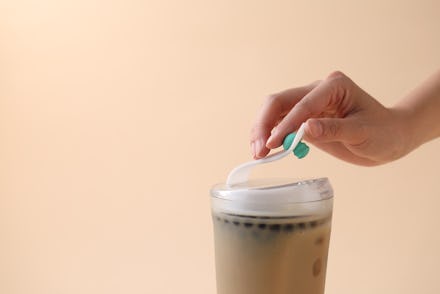As plastic straw bans continue to sweep the world, so does the prevalence of alternative drinking utensils made of everything from paper to pasta. At this point, for anyone who doesn’t need a plastic straw to drink independently or safely (as certain people with disabilities do), it’s pretty easy to do away with those used in iced coffees, cocktails or smoothies. But it’s a bit trickier for one particular beverage: bubble tea. Taiwan-based product designers Mickey Wu and Fang Shih aren't letting that deter them, though. They designed FLOAT, a strawless, reusable bubble tea cup made of glass and BPA-free plastic, which could be just the solution earth-conscious bubble tea drinkers need.
The wildly popular drink — which originated in Taiwan and features chewy tapioca “pearls” (often referred to as boba) at the bottom of the cup — is pretty dependent on a special type of straw used to consume it. Not only does it need to be wide enough to suck the pearls up from the bottom with each sip; but in many cases, it needs to be sharp enough to puncture the plastic seal that often tops bubble tea drinks, as Alvin Yu, co-owner of San Francisco’s Steep Creamery and Tea, told WBUR News in 2018. And for those who want to avoid the single-use plastic cups as well, there’s the added challenge of finding reusable tumblers that have the capacity for bubble tea (which is often served in larger sizes than other drinks, as DNA Info previously reported) and fit the wide straws.
But, as tough as it is, replacing such prevalent single-use plastic is certainly a worthy cause. Because there's a lot of it. A 2017 study published in Scientific Advances found that humans have created 9 billion tons of plastic since the 1950s; and we're not as great at recycling it as we may think. In fact, according to DoSomething.org, the EPA estimated that, of the 75 percent of recyclable waste Americans create, only 30 percent of it actually gets recycled. Much of the rest suffers a worse fate, like ending up in natural environments. According to research from Drake University, of the 300 million tons of plastic generated each year, approximately 10 to 20 tons end up in oceans.
As for bubble tea, while a quick Google search will reveal that reusable bubble tea straws and tumblers do exist, they’re not nearly as widely available as traditional options — and they come with their own set of unique pain points, as Wu and Shih discovered through research and interviews on the topic. “There are lots of reusable cups...however, most [people] stop using them after a few times,” Wu tells Mic. In addition to the cups being too small, he says people find bubble tea cups and straws hard to wash; and in terms of straws specifically, he says there are the issues of “need[ing] an extra bag...and [a] smell problem after using it for a while.”
“So, we started thinking [about] how to define a reusable cup in a different way,” Wu says. The result, of course, was FLOAT, which he and Shih recently revealed on Bēhance, an online portfolio platform for creative professionals.
The tumbler itself is made of recycled glass from Spring Pool Glass, Taiwan’s biggest glass recycler, according to Taiwan Panorama; but the real selling point for bubble tea enthusiasts is the design and placement of the small, slatted “inner cup” which holds the bubbles at the top of the drink with the tea and ice below. “The inner cup lets the boba float on the tea,” Shih tells Mic. “When you raise the cup and take a sip, the boba and tea would flow to your mouth at the same time, just like using a straw.” They even designed the lid opening to be just slightly larger than one boba, so you don’t have to worry about an excessive pearl-to-tea ratio in each sip. The inner cup and lid are made from BPA-free plastic, which, Wu says, helps keep the overall product lightweight.
The sealable cup is, theoretically, also easier to toss in your bag and take on the go than one with a straw opening; and once you’re done, easier to wash as well, without concerns about tapioca sediment building up in a straw or at the bottom of a large glass. You can just remove the small, inner cup and wash it separately. (Bonus: Both outer and inner cups are dishwasher safe.) “I think my favorite feature might be the simple structure,” Shih says. “We tried to solve many problems and improve the drinking experience by adjusting the shape and size of different parts...and that’s the reason...it is easy to wash and carry around.”
The bad news? FLOAT isn’t available quite yet. While Shih and Wu have a prototype, they’re not quite ready to go to market — but they plan to launch a crowdfunding effort and, hopefully, production, later this year. They’ll start locally in Taiwan, but from the sound of it, they may be able to take it global pretty quickly. “We receive lots of messages from [people in] different countries — more than we ever imagined,” Shih says. “We really appreciate that, [and] we are looking forward to bring[ing] this cup to other places in the future.”
